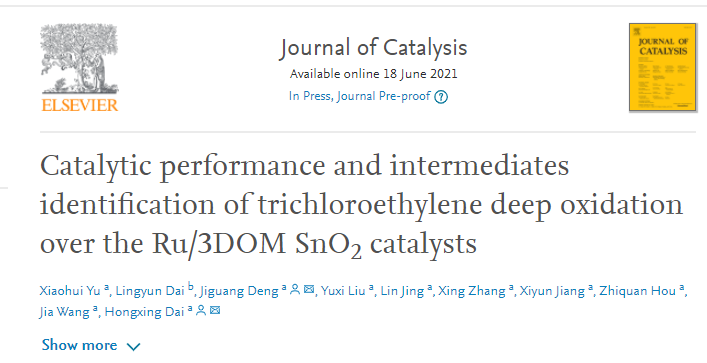博文
【北工大戴洪兴@邓积光】三氯乙烯在Ru/SnO2上的催化氧化,高活性稳定性耐水性、中间物种/副产物确定
||
https://www.sciencedirect.com/science/article/pii/S0021951721002463

Highlights
•Ru NPs with a size of 5.2−10.0 nm are dispersed on the surface of 3DOM SnO2.
•0.98Ru/3DOM SnO2 shows good catalytic activity, stability and H2O-tolerant ability in trichloroethylene oxidation.
•H2O addition produces the active HOO species, promotes the chlorine species removal, and generates more HCl and less Cl2.
•CHCl3, CCl4, C2Cl4, and CCl3CH(OH)2 are the main intermediates in TCE oxidation.
•Toluene introduction decreases the catalytic activity of trichloroethylene oxidation.
Abstract
SnO2 is widely used in catalysis owing to its presence of oxygen vacancies, reducible oxygen species, and acidity. In this work, Ru nanoparticles (NPs) supported on three-dimensionally ordered macroporous (3DOM) SnO2 (xRu/3DOM SnO2, Ru loading (x) = 0.09−1.65 wt%) were fabricated via the polyvinyl alcohol-protected reduction routes, and their catalytic activities were determined for trichloroethylene (TCE) and/or toluene oxidation. It was shown that the 0.98Ru/3DOM SnO2 sample exhibited the best activity and good thermal stability, with the temperature (T90%) at a TCE (1000 ppmv) conversion of 90 % and apparent activation energy being 300 oC and 44 kJ/mol at space velocity = 40,000 mL/(g h), respectively. Trichloromethane, carbon tetrachloride, tetrachloroethylene and trichloroacetaldehydehydrate were the main intermediates in TCE oxidation. The high catalytic performance of 0.98Ru/3DOM SnO2 was assigned to the presence of hydroxyl groups adsorbed at the oxygen vacancies, strong O2 adsorption ability, good low-temperature reducibility, and strong interaction between Ru NPs and 3DOM SnO2. In addition, the catalytic mechanism over xRu/3DOM SnO2 was proposed under the dry and humid conditions. The introduction of H2O could block some of the reaction pathways to inhibit the production of C2Cl4 and reduce formation of some by-products (e.g., CH2Cl2, CH3COOH, and C2H2Cl2), promote removal of the chlorine species, and generate a more amount of HCl and a less amount of Cl2. Furthermore, introducing toluene to the TCE stream could generate less amounts of organic chlorine by-products and more amounts of inorganic chlorine products (HCl and Cl2). We are sure that this work can provide a guideline for the industrial applications of supported Ru catalysts in the removal of Cl-containing volatile organic compounds.

https://blog.sciencenet.cn/blog-3913-1291956.html
上一篇:【天大林法伟】MnO2上CVOCs的臭氧氧化,低温、高效、高选择性、高稳定性
下一篇:【北工大梁文俊】Ru-Ce/TiO2催化剂上氯苯催化燃烧,Ce引入提高性能、降低贵金属、抑制多氯产物